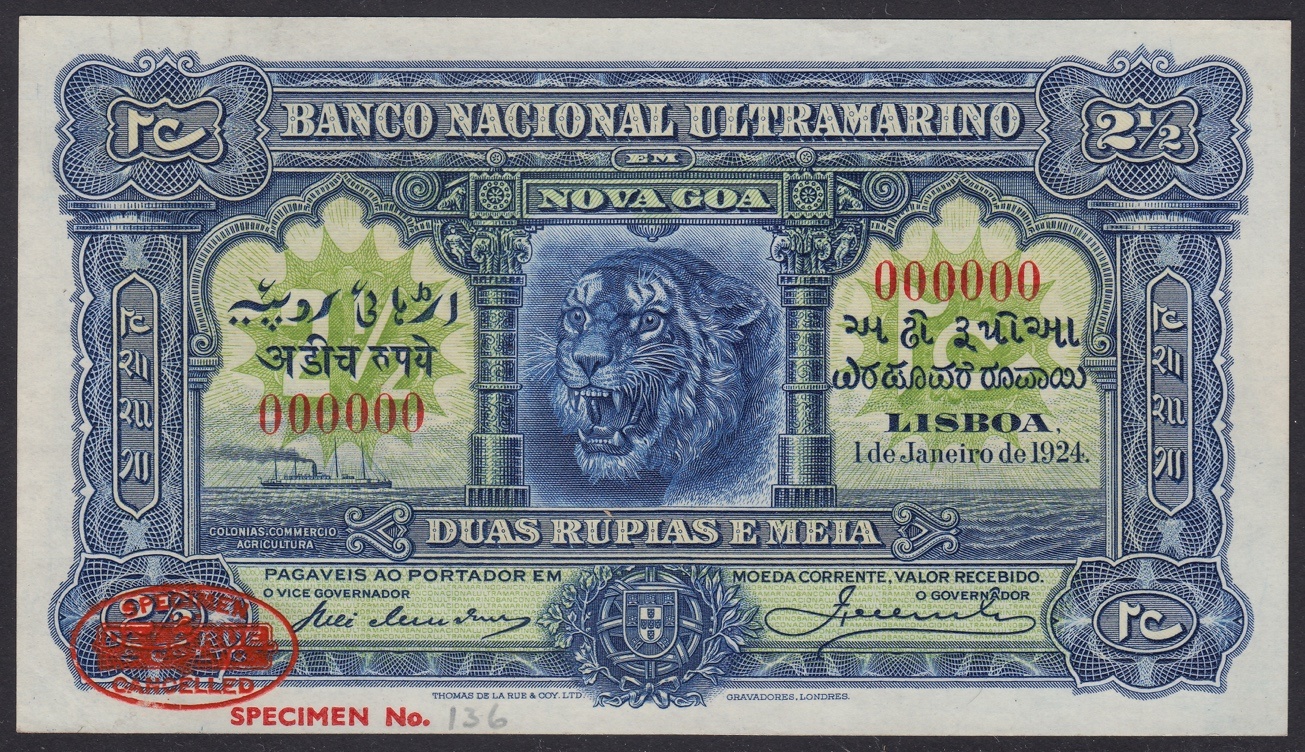Before a Currency Note is accepted for circulation, it goes through various stages - essays, patterns, proofs and finally the colour trials. Once the design is finalised after accepting the “proof”, it is necessary to determine the colour or combination of colours in which the Currency Note will ultimately be issued.
These Colour Trials were uniface, namely printed only on one side which enabled an endorsement to be made on the reverse once the Colour Trial was approved. Since these were printed in limited quantities, they are very rare. In this write-up I propose to show a few Colour Trials of Currency Notes of Portuguese India.
These Currency Notes were issued by the Banco Nacional Ultramarino, which was established in Lisbon in 1864 as a Bank of Issue for Portuguese Overseas Territories.

Fig 1: A Colour Trial of the obverse in blue and green for the 2½ Rupia issue of 1924.

Fig 2: A Colour Trial of the reverse in blue and green for the 2½ Rupia issue of 1924.
These Colour Trials were not approved, and the Currency Note was ultimately printed in dark-brown

Fig 3: The Colour Trial of the obverse in dark brown which was approved by the “Chefe” of the “Divisião de NOTAS” or the Chief of the Notes Division of the Banco Nacional Ultramarino.

Fig 4: The Colour Trial of the reverse in dark brown which was approved by the “Chefe” of the “Divisião de NOTAS” or the Chief of the Notes Division of the Banco Nacional Ultramarino. This Colour Trial also sports an oval rubber stamp of the printers, Thomas De La Rue of London.
The Colour Trials depicted if Fig.1 & Fig. 2 are both stamped “Specimen”. These are not “Specimens” in the true sense, as they are uniface. True Specimen notes are copies of the final issued notes but, overprinted “SPECIMEN, or punched and overprinted “SPECIMEN” or perforated “CANCELLED” or “SPECIMEN” so that they could not be used in circulation. These Specimen Notes often bore the Serial Nos. “000000 / 000000”. Sometimes these Specimen Notes would have an oval cachet to indicate that they had no value. These Specimen Notes were issued in order to enable Bankers and others to identify the various Currency Notes that were issued by a country.

Fig. 5: A specimen of the 600 Escudos Currency Note issued in 1959 overprinted “SPECIMEN” in red. It bears the numeral “105” in the manuscript on the top right corner, indicating that it is the 105th Specimen Note. All Specimen Notes do not bear such a number.

Fig. 6: A specimen of the 600 Escudos Currency Note issued in 1959 punched twice and overprinted “SPECIMEN” in black. In addition, on the top left and bottom right on both sides are printed an oval cachet with the legend “SPECIMEN / DE LA RUE & CO. LTD. / NO VALUE”.

Fig 7: A specimen of the 2½ Rupia Currency Note issued in 1917 perforated “CANCELLED” at the lower right.

Fig 8: A specimen of the 10 Rupia Currency Note issued in 1906 perforated “SPECIMEN” at the lower centre.

Fig. 9: A specimen of a 100 Rupia Currency Note intended to be issued in 1938. It bears the oval cachet “SPECIMEN / DELARUE & CO. LTD. / CANCELLED”. Though approved, this Currency Note was never issued.

Fig. 10: A Colour Trial in purple for the reverse of a 5 Rupia Currency Note intended for issue in 1938. This colour was not approved, and the Colour Trial does not bear any endorsement on the reverse. However, the obverse sports “R 10” in manuscript. Possibly this indicates that this was the 10th in the series of colours for this particular note. The 5 Rupia Currency Note was ultimately issued in green (Fig. 11).

Fig. 11: The 5 Rupia Currency Note that was issued in green in 1938.

Fig. 12: A Colour Trial in carmine for the reverse of a 50 Rupia Currency Note intended for issue in 1938. This colour was not approved, and the Colour Trial does not bear any endorsement on the reverse. The 50 Rupia Currency Note was ultimately issued in blackish-blue.
Several of the Currency Notes of Portuguese India were printed by Thomas De La rue & Co. of London. However, there were other entities also in the business of printing Currency Notes. Bradbury Wilkinson & Co., London had printed some of the earlier Currency Notes of Portuguese India. The Bank of England Press, Waterlow & Sons Ltd., London and later the Government Press at Nasik, India were some of their other competitors. Currency Note printers had to vie for business. Thomas De La Rue & Co. advertised by issuing samples of what they could print.

Fig. 13: Red.

Fig. 14: Pink.

Fig. 15: Dark green.

Fig. 16: Multicoloured.
Figures 13 to 16 are some of the samples issued by Thomas De L Rue & Co., London (printers inter-alia of Currency Notes and Stamps) in various colours. These particular samples appear to have been issued by Thomas De La Rue & Co. Ltd. with Portuguese India Currency Notes in mind as the Tiger’s Head flanked by Multi-pointed Stars feature on the obverse of the 1 Rupia issues of 1924 & 1929 (Figs. 17 & 18) as well as the 2½ Rupia issue of 1924 (Fig. 3).

Fig. 17: 1 Rupia issue of 1924 with a Tiger’s Head flanked by Multi-pointed Stars on the obverse.

Fig. 18: 1 Rupia issue of 1929 with a Tiger’s Head flanked by Multi-pointed Stars on the obverse.
